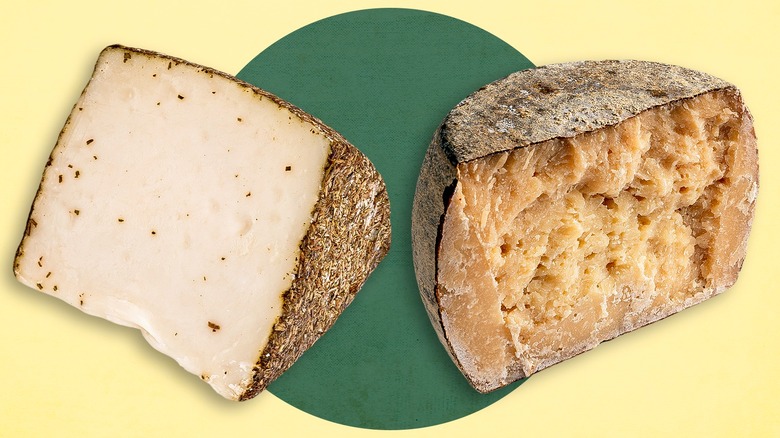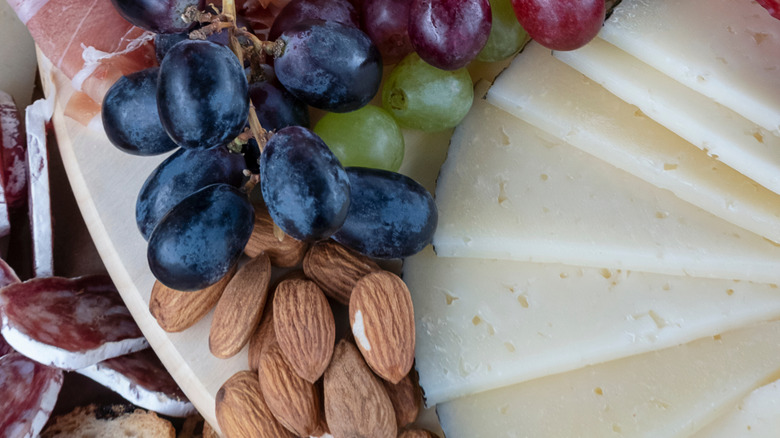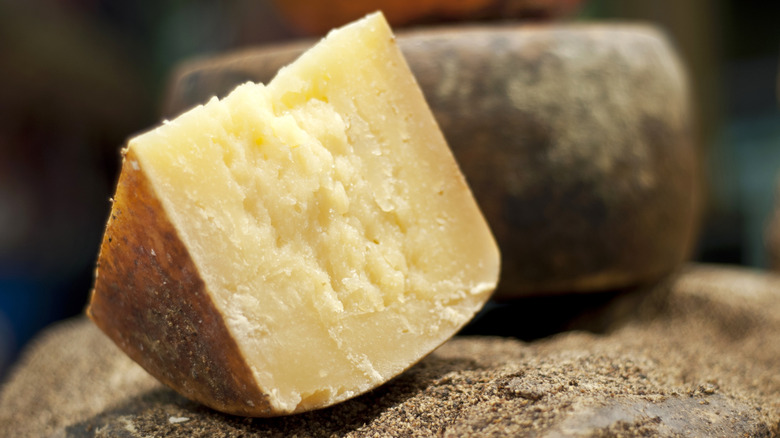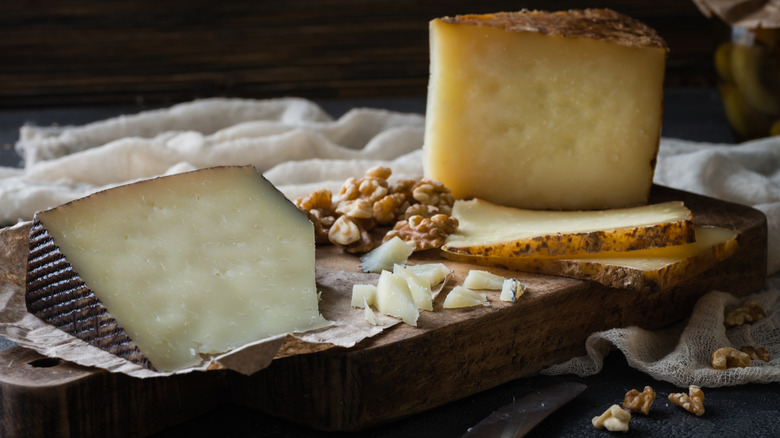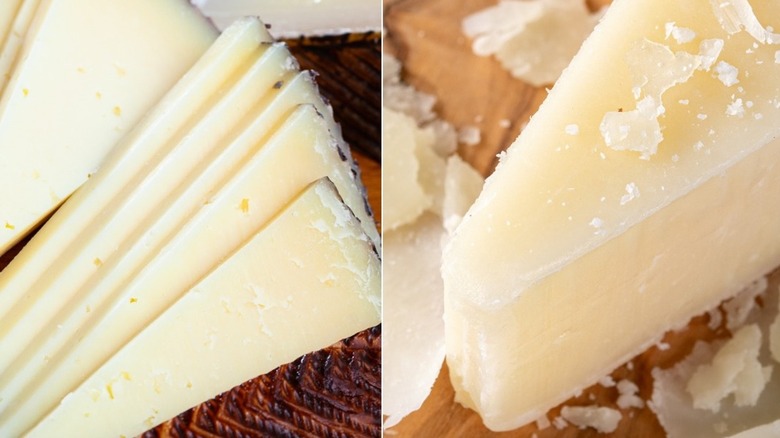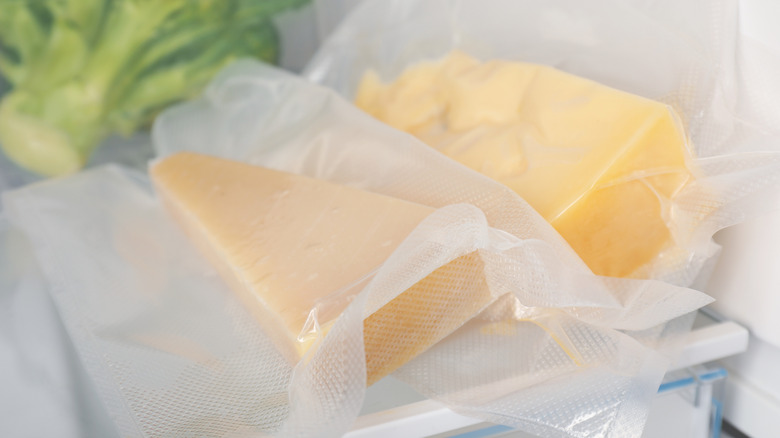The Difference Between Manchego Cheese And Pecorino Romano
We may receive a commission on purchases made from links.
The deeper you look into the cheese section at your grocery store, the more differences you'll see. And while you may know what to expect from cheddar or mozzerella, understanding what sets two hard cheeses like Manchego and Pecorino Romano apart is a different matter. Consider this your opportunity to peek beneath their rinds and learn more about the distinctions between the two.
First, let's consider what they have in common. For one thing, you may notice that both names are capitalized, and with good reason. Each of these cheeses has a Protected Destination of Origin (PDO) designation, meaning they must be made in a certain region – a key label to look for when shopping for European cheeses. Their names stem from places you can find on a map — La Mancha, Spain and parts of Italy in the former Roman Empire, so they're always capitalized. While they come to us from two different parts of Europe, both cheeses are also made with pasteurized sheep's milk, along with salt and the enzyme rennet. With nearly twice the fat and protein of cow's milk, sheep's milk gives each of them a rich flavor, along with a hint of wooly and hay-like tang that some describe as "sheepy."
What is Manchego cheese?
This storied cheese has been made in the central region of Spain since the Bronze Age — the same area associated with the fictional Don Quixote, the man of La Mancha. It can only be made with milk from Manchega sheep and is aged for at least 60 days, depending on the size of the cheese and the flavor profile the makers want to achieve. When mature, it is firm and buttery with a pale yellow color and a grassy scent. It's typically covered with a gray or tan zig-zag patterned rind that is not meant to be eaten.
Manchego has both sweet and savory uses. It's often served with grapes, apples, pears, or figs or drizzled with honey to enhance their sweetness. You can also pair it with salty foods like brined olives or cured meats. When it comes to drinks, light, dry wines, whiskey, and green tea complement younger cheeses with milder flavors. Well-aged cheeses with more pronounced sheepiness are a nice match with red wines, IPAs, stouts, and tawny ports. They can also hold their own against funky sour ales and hard ciders.
What is Pecorino Romano cheese?
Like Manchego, this cheese has ancient roots, dating back to Roman times in Lazio, Sardinia, and the Province of Grosseto in Tuscany, Italy. It's traditionally made from October through July each year, using a blend of sheep's milk collected in both the morning and evening. Each cheese is aged for five to 12 months or even more, with trained cheesemakers periodically washing them with brine throughout the process. When mature, it is hard and straw-colored, with a black or dark gray rind.
This Italian specialty can be eaten on a cheese board with fresh or dried fruit that contrasts well with its saltiness. Other popular ways to use it include grating it over pasta, stirring it into risotto, or layering it into gratins. Plus, it's delicious sprinkled over salads of bitter greens like arugula or spinach. When it comes to wine, look for robust reds that won't disappear behind its bold flavor, such as cabernet sauvignon or Chianti.
A spectrum of flavors
While the sheep's milk flavor underlines both cheeses, they do taste distinctly different. Cut into a wheel of Manchego, and you'll notice a nutty, tangy flavor. This comes from amino acid compounds that are formed when milk proteins break down. Underlining these notes is a distinct creaminess due to the high fat content: approximately 11 grams for every one-ounce serving. As the cheese matures, its undertones change from fruity and tangy to nutty and finally almost peppery.
But what does Pecorino Romano taste like? Pecorino Romano is known for its sharp and salty characteristics, thanks in part to the frequent brine baths it receives as it matures. With an older cheese, you may be able to smell the salt even before you cut into it. Containing approximately 9 grams of fat per ounce, it's still richly flavored, but not quite as creamy as Manchego.
The older the cheese you choose, the more distinct these differences will be. This is because the enzymes and friendly microbes in the cheese keep developing as it ages. Together, they transform the natural lactose in the milk into lactic acid, enhancing the bold, sharp flavors that gourmets prize while building other amino acids with unique taste personalities. To make the most of these characteristics, bring your samples to room temperature before serving, allowing the fat molecules to open up and release their aromas.
Creamy or crumbly
The difference in textures is another way to set these varieties apart. If you test them side-by-side, you'll see that Manchego, while still being a hard cheese, is softer and easier to cut into slices. It has a buttery smoothness that almost melts in your mouth.
Meanwhile, Pecorino Romano quickly crumbles under pressure from a knife. You won't get a smooth slice, but the little crumbles and flakes are well suited for grating. Their small size helps them work into all the nooks and crannies of your salad or pasta, offering flavor in every bite. This cheese can also have a distinctive grainy texture. This occurs when proteins break down during aging, leaving amino acids that form into tyrosine crystals.
Note that neither cheese is well suited for melting. Since they're made with sheep's milk, they both contain a lot of fat and protein. When exposed to heat, some of that fat is released, becoming oily instead of melting smoothly.
How long they keep
In general, Manchego has a shorter storage life than Pecorino Romano — and the younger the cheese, the faster it should be consumed. Once opened, a young Manchego should be eaten within a couple of weeks for the best taste and texture. One that has aged for longer may keep for up to several months, especially if you wrap it in wax paper or seal it in a vacuum bag.
An unopened Pecorino Romano may last months or weeks beyond its "best by" date. However, once you've opened it, expect it to last anywhere from a few weeks to two months. Again, it will stay fresh longer if you wrap it tightly and keep it in an airtight bag or container. Those steps will also prevent it from absorbing other smells and tastes from your fridge. The flavor of these cheeses has been perfected over centuries, so you don't want anything to interfere with them!
What you'll pay
At last check, a 2-pound wheel of Manchego was $52.99, while the same size of Pecorino Romano commanded $43.98. While varying market forces (for example, a recent outbreak of sheep pox in La Mancha that forced farmers to cull their herds) may give one the edge at any given time, both varieties tend to be among the higher-priced options at your cheesemonger. There are multiple reasons why they command a premium.
First, they're made from sheep's milk, which is produced at much lower volumes than cow's milk. While cows produce 83% of the world's milk, sheep make only 1.3%. Secondly, both varieties are Protected Denomination of Origin (PDO) products. This defines the area where they can be made and dictates the production methods that can be used, including the lengthy, labor-intensive aging process. Thirdly, people love them! Manchego's popularity around the world has grown exponentially over the past decade, and there's also been a boom in global sales of Pecorino Romano. According to the law of supply and demand, all of these factors make them more expensive. What's more, imported sheep cheese is taxed at 9.6%, and these tariffs get passed on to US customers.
Despite the high price point, there's nothing else that can compare to the rich flavors of these cheeses. So head to your local market and pick up a slice of one — or both! You'll find they're worth every penny.
